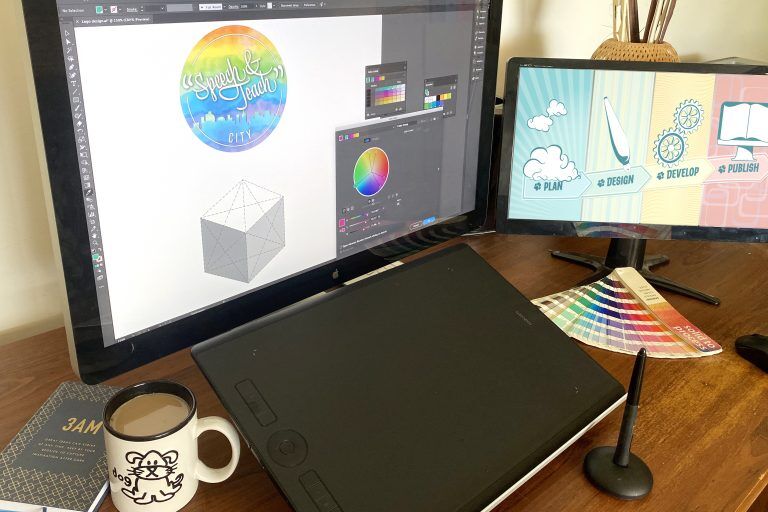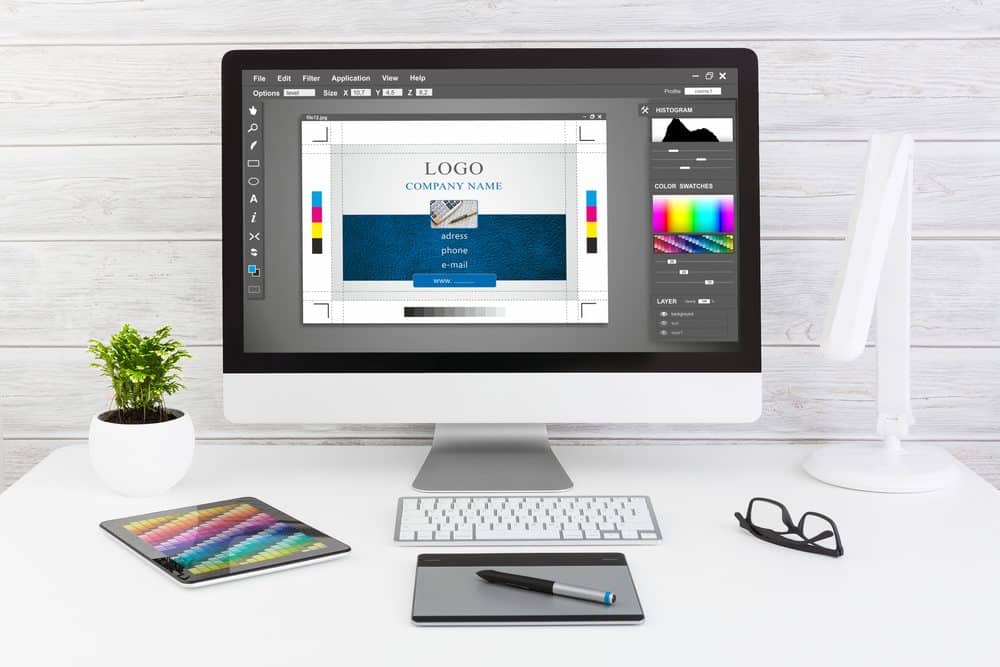
In the competitive landscape of small businesses, effective logo design and branding play a crucial role in establishing a strong market presence. However, many small businesses often fall prey to common mistakes that hinder their brand's success.
This article explores ten key logo design and branding mistakes that small businesses must avoid. By understanding these pitfalls and implementing effective strategies, small businesses can enhance their brand's visibility, appeal, and ultimately, their chances of success in the marketplace.
Lack of Clarity in the Logo Design
One of the most common mistakes small businesses make in logo design is a lack of clarity, which can lead to confusion and a failure to effectively communicate the brand's message.
Clarity enhancement is crucial in logo design as it helps to ensure that the message and identity of the brand are easily understood and recognized. A visually appealing logo with clear visual messaging can capture the attention of potential customers and create a lasting impression.
By using clear and concise design elements, such as simple shapes, legible fonts, and well-defined colors, small businesses can enhance the clarity of their logo and effectively convey their brand's message.
A clear and visually appealing logo can also instill confidence and trust in customers, ultimately boosting the success of the business.
Failing to maintain consistent branding across different platforms can undermine the credibility and recognition of a small business. In today's digital age, where businesses interact with customers across various channels, having an incomplete branding strategy or inconsistent visual identity can be detrimental to a company's success.

Here are four reasons why consistent branding is crucial:
Builds trust and credibility: Consistency in branding creates a sense of reliability and professionalism, which fosters trust among customers and potential clients.
Enhances brand recognition: By using consistent visuals, colors, and messaging across different platforms, businesses can create a strong and recognizable brand identity.
Improves customer loyalty: Consistent branding helps customers develop a connection with a business, leading to increased loyalty and repeat purchases.
Sets businesses apart from competitors: Inconsistent branding can confuse customers and make a business blend in with the competition. Consistency helps businesses stand out and be memorable.
Therefore, small businesses must prioritize maintaining a consistent branding strategy and visual identity across all platforms to maximize their success and growth.
Poor Color Choices in the Logo Design
When selecting colors for a logo design, small businesses must be cautious to avoid poor color choices that can negatively impact their brand image and recognition. Color psychology plays a significant role in how consumers perceive a brand, as different colors evoke different emotions and associations. For instance, red can signify passion and excitement, while blue can symbolize trust and reliability.

It is essential to consider the target audience and the message the brand wants to convey when choosing colors. Furthermore, visual appeal is crucial in logo design, as it helps capture the attention of potential customers. A well-designed logo with appropriate color choices can make a brand stand out and create a lasting impression, leading to increased brand recognition and customer loyalty.
Overcomplicated or Cluttered Logo Design
When it comes to logo design, simplicity is key. Overcomplicating or cluttering your logo design can make it visually overwhelming and difficult to understand.
Simplify Logo Design
An excessive amount of elements can lead to a convoluted and confusing logo design, hindering the brand's ability to convey its message effectively. When it comes to logo design, simplicity is key.
Here are four reasons why simplifying your logo design is crucial for effective logo communication:
Memorable: A simple logo is easier to remember and recognize, creating a lasting impression in the minds of your audience.
Versatile: Simplified logos are more versatile and can be easily adapted across different mediums, ensuring consistency in your brand's visual identity.
Timeless: Simple designs have a timeless quality, allowing your logo to remain relevant and effective for years to come.

Clarity: By removing unnecessary elements, your logo becomes clearer and communicates your brand's message more effectively.
Avoid Visual Overcrowding
Excessively cluttered or overcomplicated logo designs should always be avoided by small businesses, as they can diminish the impact and effectiveness of the brand's visual identity. When it comes to logo design, simplicity is key.
Small businesses must strive to simplify design elements and use negative space effectively to create a clean and memorable logo. Visual overcrowding can confuse the audience and make it difficult for them to understand the brand's message. By simplifying the design, small businesses can create a logo that is visually appealing and easy to recognize.
Using negative space effectively can also help in creating a logo that is visually balanced and allows the important elements to stand out. Remember, a cluttered logo can detract from the brand's identity and make it less memorable.
Ignoring the Importance of Typography in Branding
Many small businesses make the mistake of overlooking the significance of typography in their branding strategies. Typography plays a crucial role in conveying the right message and creating a strong visual identity for a brand. Here are four reasons why typography should never be ignored in branding:
Typography reflects the brand personality: The choice of font can communicate the brand's values, tone, and style to the audience. It helps create a visual language that resonates with the target market.
Typography enhances readability: The right font choice ensures that the brand's message is easily readable and understandable. It improves user experience and makes the content more accessible.

Typography distinguishes the brand: Unique typography sets a brand apart from its competitors and helps it stand out in a crowded market. It creates a memorable and recognizable visual identity.
Typography keeps the brand consistent: Consistent use of fonts across all brand materials, including logos, websites, and advertisements, helps maintain a cohesive brand image and builds trust with the audience.
Failing to Consider Scalability of the Logo Design
When designing a logo for a small business, it is crucial to consider the scalability of the design.
Size limitations can affect how the logo appears across different mediums, such as on a website or promotional materials.
Maintaining brand consistency is another key aspect of scalability, ensuring that the logo is recognizable and impactful regardless of its size.
Additionally, resizing a logo without considering its scalability can lead to distortion or loss of important design elements, ultimately affecting the overall effectiveness of the brand.
Size Limitations: Scalable Logos
One common mistake small businesses make in logo design and branding is failing to consider the scalability of their logo design. It is crucial for a logo to be scalable, meaning it can be resized without losing its design integrity.

Here are four reasons why logo scalability is important:
Versatility: A scalable logo can be used across various platforms and mediums, from business cards to billboards, ensuring consistent brand recognition.
Adaptability: As your business grows and expands, your logo needs to adapt to different sizes and formats without losing its impact or legibility.
Brand Consistency: A scalable logo allows you to maintain brand consistency across different marketing materials, reinforcing your brand identity.
Future-proofing: By designing a scalable logo from the start, you save time and money in the long run, as you won't need to redesign or recreate your logo for different purposes.
Brand Consistency: Scalable Design
To ensure brand consistency, small businesses must always consider the scalability of their logo design over time and across various marketing materials.
Scalable design refers to the ability of a logo to be resized without losing its visual quality or legibility. Failing to consider logo scalability can lead to inconsistent branding and a lack of professionalism.

A logo that looks great on a website header may become distorted or unreadable when printed on a small business card or enlarged for a billboard. It's essential for small businesses to create a logo design that can be easily adapted to different sizes and formats, ensuring that their brand remains visually appealing and recognizable across all marketing channels.
Impact of Resizing: Logo Scalability Effects?
Failing to consider the scalability of a logo design can have a detrimental impact on a small business's branding efforts. Logo resizing challenges can arise when a logo is not designed with scalability in mind. Here are four reasons why scalability is important for branding:
Consistency: A scalable logo ensures that your brand image remains consistent across different platforms and sizes.
Legibility: A logo that is not scalable may lose its readability when resized, leading to confusion and a lack of recognition.
Versatility: A scalable logo allows for versatility in its application, making it adaptable to various marketing materials and mediums.
Professionalism: A well-designed and scalable logo exudes professionalism and attention to detail, enhancing your brand's credibility and perception.
Considering the importance of scalability for branding is crucial to avoid the negative effects of logo resizing challenges.

Lack of Uniqueness and Originality in the Logo Design
Several small businesses make the mistake of creating logo designs that lack uniqueness and originality, which can negatively impact their brand identity. When businesses choose uninspiring design choices for their logos, they miss out on the opportunity for effective brand storytelling.
A logo should be more than just a simple graphic or text; it should tell a story and evoke emotions that resonate with the target audience. By using generic and unoriginal designs, businesses fail to create a visual identity that sets them apart from competitors and fails to capture the attention of potential customers.
Uniqueness and originality in logo design are essential for creating a strong and memorable brand presence in the market. Small businesses should invest time and effort into creating a logo that reflects their brand values and tells a compelling story to make a lasting impact.
Neglecting to Research and Understand the Target Audience
One of the key mistakes that small businesses often make when designing their logo and branding is neglecting to research and understand their target audience.
This can lead to a lack of market research and a lack of understanding of what will resonate with their customers.
Target Audience Ignorance
Lack of market research and understanding of the target audience is a costly mistake that small businesses must avoid when it comes to logo design and branding. Ignoring the target audience can result in missed opportunities for engagement and ineffective communication.
Here are four reasons why small businesses should prioritize researching and understanding their target audience:

Better connection: By knowing the needs, preferences, and values of their target audience, businesses can create a logo and brand identity that resonates with them on a deeper level, fostering a stronger connection.
Increased relevance: Understanding the target audience allows businesses to tailor their messaging and design elements to be more relevant and appealing, increasing the chances of capturing their attention and standing out in a crowded market.
Enhanced loyalty: When businesses demonstrate that they understand their target audience's desires and concerns, it builds trust and loyalty, leading to long-term customer relationships and repeat business.
Competitive advantage: By conducting thorough market research, small businesses can gain insights into their competitors' strategies and identify gaps in the market, allowing them to position themselves uniquely and gain a competitive advantage.
Lack of Market Research
Without proper market research, businesses risk overlooking the crucial step of understanding their target audience, leading to ineffective logo design and branding strategies.
Market analysis and competitor research play a vital role in identifying the needs, preferences, and behavior of the target market, enabling businesses to create a strong brand identity.
Market analysis helps businesses identify market trends, customer demographics, and their purchasing power, allowing them to tailor their branding efforts accordingly.

Competitor research, on the other hand, helps businesses understand how their competitors are positioning themselves in the market and identify opportunities for differentiation.
By neglecting market research, small businesses may fail to resonate with their target audience, resulting in wasted resources and missed opportunities for growth.
Therefore, conducting thorough market research is essential to create a successful logo design and branding strategy.
Ineffective Use of Negative Space in the Logo Design
The improper utilization of negative space in the logo design can result in a confusing and cluttered visual representation for small businesses. Negative space, also known as white space, is the area around and between the elements of a logo. When used effectively, negative space can enhance the overall design and create a memorable and impactful logo. However, when used ineffectively, it can lead to confusion and a lack of clarity in the message being conveyed.
To avoid this mistake, small businesses should:
Keep it simple: Avoid overcrowding the logo with excessive elements, and instead, embrace the power of simplicity.
Balance the elements: Ensure that the negative space is evenly distributed throughout the design, creating a harmonious and visually appealing logo.

Highlight the focal point: Use negative space to draw attention to the main element or message of the logo, making it more memorable and impactful.
Test and iterate: Continuously evaluate the effectiveness of the negative space utilization in the logo design and make adjustments as needed to achieve the desired impact.
Failure to Align the Logo Design With the Company's Values and Mission
Failure to align the logo design with the company's core values and mission can result in a disconnect between the brand identity and its intended message. When creating a logo, it is crucial to ensure that it accurately reflects the values and mission of the company.
A logo serves as a visual representation of the brand, and it should communicate the company's purpose and goals to the target audience. The alignment with values and mission creates a strong brand identity and helps build trust and credibility with customers.
Moreover, the impact of logo design on brand perception cannot be understated. A well-designed logo that aligns with the company's values and mission can enhance brand recognition and create a positive impression in the minds of consumers.
Therefore, it is essential for small businesses to carefully consider the alignment of their logo design with their core values and mission to create a powerful and effective brand image.
Frequently Asked Questions
How Can a Small Business Ensure Clarity in Their Logo Design?
To ensure clarity in their logo design, small businesses should prioritize consistency and effective communication. By maintaining a cohesive visual style and using appropriate imagery and typography, businesses can convey their brand message clearly and leave a lasting impression on their audience.

Common mistakes small businesses make when it comes to branding across different platforms are inconsistency and lack of clarity. These errors can lead to confusion among customers and hinder the establishment of a strong and cohesive brand identity.
How Can Small Businesses Avoid Poor Color Choices in Their Logo Design?
To avoid poor color choices in logo design, small businesses should prioritize research and understand the importance of color psychology in branding. Colors evoke emotions and convey messages, so selecting the right ones can greatly impact brand perception and customer response.
What Are Some Tips for Creating a Simple and Effective Logo Design That Isn't Overcomplicated or Cluttered?
When creating a logo design, it is important to consider current logo design trends and prioritize simplicity. A simple and effective logo design is not overcomplicated or cluttered, which helps to establish a strong brand identity.
Why Is Typography Important in Branding, and How Can Small Businesses Ensure They Are Using It Effectively?
Typography is crucial in branding as it helps convey a consistent message and evoke the desired emotions. Small businesses can ensure effective usage by following best practices such as choosing legible fonts, maintaining consistency across all platforms, and considering the visual hierarchy.
 Digital Art InstructionDIY Infographics DesignMobile Game ArtworkPersonalized Logo Design3D AnimationeBook Covers DesignPrivacy PolicyTerms And Conditions
Digital Art InstructionDIY Infographics DesignMobile Game ArtworkPersonalized Logo Design3D AnimationeBook Covers DesignPrivacy PolicyTerms And Conditions
